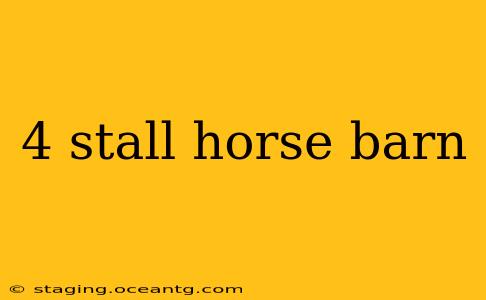Owning horses is a rewarding experience, but providing them with proper shelter is crucial for their health and well-being. A well-designed 4-stall horse barn offers ample space for your equine companions and essential storage for tack and hay. This guide delves into the key considerations for building or buying the perfect 4-stall horse barn, addressing common questions and concerns.
What are the different types of 4-stall horse barns?
Several factors influence the design and style of your 4-stall barn. The most significant are the overall style (pole barn, gambrel roof, monitor barn, etc.), material (wood, metal, or a combination), and the layout of the stalls and supporting areas. Pole barns, known for their affordability and ease of construction, are popular choices. Gambrel roof barns offer more headroom in the loft area, while monitor barns provide excellent ventilation. Material choice influences cost, maintenance, and durability; wood offers a classic aesthetic while metal is known for its longevity and low maintenance. Consider the climate; metal barns might get excessively hot in summer unless properly insulated.
What size should a 4-stall horse barn be?
The ideal size depends on the size of your horses and the additional space you need. A general guideline suggests each stall should be at least 12 feet by 12 feet, but larger stalls (12x14 or even 14x14) are more comfortable, especially for larger breeds. Beyond the stalls, you'll need space for a tack room, feed storage, and potentially a wash stall. A minimum overall barn size of 40 feet by 40 feet is a good starting point for a four-stall barn with these additional areas, but you should always tailor the size to your specific needs and the size of your horses.
What features should I consider for my 4-stall horse barn?
Beyond basic stall dimensions, several features enhance functionality and horse well-being:
- Ventilation: Proper ventilation is paramount to prevent ammonia buildup and maintain a healthy environment. Consider ample windows, vents, and potentially a cupola.
- Lighting: Natural lighting is best, supplemented by adequate artificial lighting for safety and visibility, especially in winter.
- Run-in sheds: Adding run-in sheds to your barn design provides extra shelter and grazing space for your horses outside the main stalls.
- Drainage: Ensure proper drainage around the barn to prevent water accumulation and potential flooding.
- Stalls: Choose appropriate stall fronts (vertical or horizontal bars) for safety and consider mats for comfort and hygiene.
How much does a 4-stall horse barn cost?
The cost of a 4-stall horse barn varies significantly depending on location, size, materials, and features. A basic pole barn might cost between $20,000 and $40,000, while a more elaborate custom-built barn with high-end materials and features can cost upwards of $100,000 or more. Consider obtaining multiple quotes from different builders to compare prices and services.
What permits are needed to build a 4-stall horse barn?
Building permits and zoning regulations vary significantly by location. Contact your local building department and zoning office early in the planning process to determine what permits are required, as well as any restrictions on barn size, location, and design. Failure to obtain necessary permits can result in significant fines and even demolition orders.
What are the best materials for a 4-stall horse barn?
The best materials depend on your budget, climate, and aesthetic preferences. Wood is a classic choice, offering a warm aesthetic and good insulation, but requires more maintenance. Metal is durable, low-maintenance, and often more affordable but can get very hot in summer. Hybrid structures combining wood and metal offer a good compromise between cost, durability, and aesthetics.
By carefully considering these aspects, you can create a 4-stall horse barn that's both functional and provides a safe, comfortable environment for your horses for years to come. Remember to always prioritize your horses' well-being and safety in your design choices.
